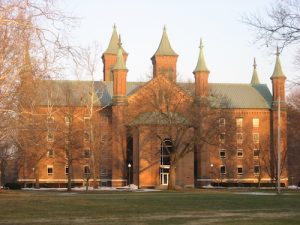With enough intensity and focus to rival many professional athletes, 431 “mathletes” from 37 local schools competed last week at the 24th Annual South Coast Math Superbowl.
Vieja Valley School took the top prize, defeating 2004 champion Washington School. Kellogg School was in third place, followed by Monte Vista, Cold Spring and Hope Schools.
Each school uses its own screening process to choose the participating mathletes.
At Monte Vista, for example, coach Kim Barney said the entire top math group is given a test to qualify. “I take the top 12 and work with them for about two weeks and then they take another qualifying test and weed it down to five, four team members and one alternate.”
Each school was allowed to field three four-person teams of fourth, fifth and sixth graders. The overall team scores were made up of a combination of individual multiple choice test scores and a team test. There was also a hands-on activity, with separate awards, where teams were challenged to build the tallest freestanding structure they could out of straws, washers and string.
While team members can vary from year to year, Monte Vista’s sixth grade team of Ben Bordofsky, Ryan Gilmore, Johnny Manzo, Ben McKenzie and Amy Ransohoff has been competing together since fourth grade, with the alternates alternating from year to year.
“They’re very motivated to win. They want it again,” said their teacher and coach Lila Allen. The team won in fourth grade and came in second last year, but alas, this year they placed third. They did get a little consolation, however when Bordofsky, Manzo, McKenzie and Ransohoff each won individual medals (Gilmore was the 2005 alternate and not eligible).
Plus, they got the added benefit of “going out for pizza afterward and higher test scores,” laughed Barney.
The winning sixth grade team was from Washington, with Vieja Valley in second place, followed by Monte Vista, Adams, Kellogg and Hope School.
The fifth grade winning team was from Kellogg, followed by Vieja Valley, Washington, Mountain View, Monte Vista and Montecito Union tied for fifth place, and Cold Spring was in sixth place.
Vieja Valley won the fourth grade title, followed by Cold Spring, Kellogg, Washington, Hope and Monte Vista schools.
Hosted by Montecito Union, Cold Spring and Peabody Charter schools the Santa Barbara County Education Office, and Raytheon Vision Systems, representatives awarded individual Olympic-style medals to:
4th Grade School
1st Hanah Koper Vieja Valley
2nd Helen Yang Adams
3rd Eugene Cho Kellogg
4th Agnetta Cleland Vieja Valley
4th Kevin Hempy Vieja Valley
4th Kyle Mayfield Cold Spring
5th Alex Kolarczyk Washington
5th Colin Fristoe Cold Spring
5th Rishika Singh Kellogg
6th Sedric Kim Mountain View
5th Grade School
1st Devin Pearson Adams
2nd Vy-Luan Huynh Kellogg
3rd Ryne Cannon Santa Ynez
4th Thanh-Liem Huynh-Tran Crane
4th Sadnie D’Arcy Montessori
4th Connie Wang Brandon
5th Laura Voyen Kellogg
5th Jackie Botts Mountain View
5th Chloe Warinner Monte Vista
5th Astron Liu Monte Vista
5th Annie Thwing Vieja Valley
6th Avery Schwartz Montecito Union
6th Janine Wilson Kellogg
6th Jake Moghtader Cold Spring
6th Tim Cronshaw Montecito Union
6th Nicholas Carney Monroe
6th Grade School
1st Peter Bang Vieja Valley
2nd Dillon Kraus Washington
2nd Noah Connally Adams
2nd Fabian Chacon Kellogg
2nd Nicholas Below Washington
2nd Ellen Gleason Hope
2nd Qsi Tran Montecito Union
2nd Robie Behlman Adams
3rd Ben Bordofsky Monte Vista
3rd Danny Zandona Washington
3rd Jordan Carlson Adams
3rd Annie Lefley Kellogg
4th Chloe Hughes Roosevelt
4th Matt Swann Hope
4th Johnny Manzo Monte Vista
4th Louis Warne Vieja Valley
5th Cong Dinh Brandon
5th Michael Shaner Brandon
5th Ben McKenzie Monte Vista
5th Nicole Ferrel Roosevelt
5th Melinda Wilson Ballard
5th Kelly Kosmo Mountain View
5th Carly Biedul Crane
5th Sebastian Gomez-Devine Peabody Charter
5th Sergey Sushchikh Isla Vista
5th Simon Manson-Hing Washington
5th Kayvoh Mazooji Peabody Charter
5th Jason Lew May Grisham
5th Amber Wang Ellwood
6th Christian Mkpado Vieja Valley
6th Amy Ransohoff Monte Vista
6th Al Vorosmarthy Isla Vista
6th Aislinn Dunne Cold Spring
Originally published in South Coast Beacon on May 26, 2005.






